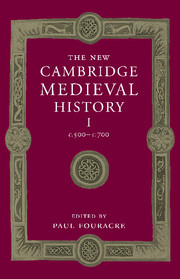Book contents
- Frontmatter
- Introduction: the history of Europe 500–700
- 1 The later Roman Empire
- 2 The Barbarian invasions
- 3 The sources and their interpretation
- PART I THE SIXTH CENTURY
- PART II THE SEVENTH CENTURY
- 11 The Byzantine empire in the seventh century
- 12 Muhammad and the rise of Islam
- 13 The Catholic Visigothic kingdom
- 14 Francia in the seventh century
- 15 Religion and society in Ireland
- 16 Christianity amongst the Britons, Dalriadan Irish and Picts
- 17 England in the seventh century
- 18 Scandinavia
- 19 The Slavs
- PART III THEMES AND PROBLEMS
- List of Primary sources
- Bibliography of secondary works arranged by chapter
- Index
- Frontispiece"
- Plate section"
- Map 3 Gaul/Francia in the sixth and seventh centuries"
- References
11 - The Byzantine empire in the seventh century
from PART II - THE SEVENTH CENTURY
Published online by Cambridge University Press: 28 March 2008
- Frontmatter
- Introduction: the history of Europe 500–700
- 1 The later Roman Empire
- 2 The Barbarian invasions
- 3 The sources and their interpretation
- PART I THE SIXTH CENTURY
- PART II THE SEVENTH CENTURY
- 11 The Byzantine empire in the seventh century
- 12 Muhammad and the rise of Islam
- 13 The Catholic Visigothic kingdom
- 14 Francia in the seventh century
- 15 Religion and society in Ireland
- 16 Christianity amongst the Britons, Dalriadan Irish and Picts
- 17 England in the seventh century
- 18 Scandinavia
- 19 The Slavs
- PART III THEMES AND PROBLEMS
- List of Primary sources
- Bibliography of secondary works arranged by chapter
- Index
- Frontispiece"
- Plate section"
- Map 3 Gaul/Francia in the sixth and seventh centuries"
- References
Summary
Most centuries can be claimed to have been, in one way or another, a watershed for Byzantium, but the case for the seventh century is particularly strong. At the beginning of the century, the Byzantine Empire was part of a political configuration focussed on the Mediterranean world, that had been familiar for centuries and was characterised by two factors, one external and the other internal. Internally, the basic economic unit of that world was the city and its surrounding territory, which, although it had by now lost much of its political significance, still retained much of its social, economic and cultural position. Externally, however, it was a Mediterranean world: bounded to the east by the Persian Empire, most of the regions that surrounded the Mediterranean formed a single political entity, the Roman (or Byzantine) Empire. At the beginning of the seventh century, this traditional configuration was already being nibbled away: much of Italy was under Lombard rule, Gaul was in Frankish hands, and the coastal regions of Spain, that had been the final acquisition of Justinian’s reconquest, were soon to fall to the Visigoths. But by the end of the century, this whole traditional configuration had gone, to be replaced by another, which was to be dominant for centuries and still marks the region today. The boundary that separated the Mediterranean world from the Persian Empire was swept away: after the Arab conquest of the eastern provinces in the 630s and 640s, that boundary – the Tigris–Euphrates valley – became one of the arteries of a new empire, with its capital first in Damascus (660–750) and then in Baghdad (from 750), which by the middle of the eighth century stretched from Spain in the west to the valleys of the Oxus and the Indus in the east.
Keywords
- Type
- Chapter
- Information
- The New Cambridge Medieval History , pp. 289 - 316Publisher: Cambridge University PressPrint publication year: 2005



